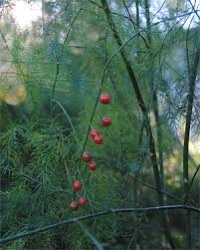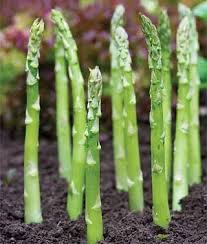Asparagus is a spring time treat, and a perennial vegetable as well. It grows tall in the summer with pretty, lacy foliage Asparagus came to the States in colonial times. It dates back to Egyptian times 3000BCE and is thought to have been domesticated by the Moors in Spain. In the wild, the spears are about the width of a pencil. The type we enjoy today was developed in the 18th century.
Asparagus has good nutrition, being low carb with moderate protein, fiber, vitamins A, C and E, iron, folate, riboflavin, and thiamine. It has 70% of daily recommended vitamin K. Asparagus nutritional profile
Asparagus will last in the garden for 15 to 20 years. Asparagus is a hardy perennial and will survive winters even in Zone 3. The mature plants will be 4-5 feet tall. It takes 2-3 years after planting to be able to harvest. The plant needs time to fully establish its root system. Establish new plants in spring or fall. Buying crowns to plant may accelerate your first harvest.
It is the first shoots of the plant that are harvested in spring and eaten. Once the plant begins to fill out, they become woody and don't taste that great. Asparagus plants grow quite large so should be planted in rows 6 feet apart. The plants themselves can be planted 1 foot apart in the row. Asparagus plants have fernlike foliage. You can either plant them off by themselves or along the back of the garden bed. Just be sure to have a way to get to them for harvesting and fertilizing in the spring.
 |
| Mature asparagus plants |
You can start seeds indoors as early as 60-90 days prior to last frost and transplant seedlings outdoors as soon as danger of frost has passed when daffodils are fading and soil temperature reaches 50 degrees F.
 |
| Baby asparagus plants |
The first year of planting, you will not harvest spears. You can harvest for 2-3 weeks in the second year and 6 weeks the following years. It is best to leave the smallest spears to help support the roots and leaves of the plant to give stronger harvests year after year. Fertilize early in spring and again after harvest each year.
It is the male plant that produces the larger, thicker spears whereas the female plants produce small berries (seeds). Each asparagus plant is dioecious, meaning they are both male and female. That is why you will see in the description of the variety what percentage of the plants will be female and what percentage will be male. To have a productive asparagus bed, remove the female plants. Be sure to take this into account when you plant your bed as you will need to plant more than you will end up leaving in the garden.
Pests of asparagus are the asparagus beetle, slugs. You can use pyrethrin for the beetles and slug traps or baits to keep the slugs under control. I recently saw wool pellets that you sprinkle around your plants that are susceptible to slugs and the pellets will expand into woolly balls that slugs won't cross so that is another option.
Asparagus is susceptible to fusarium wilt and stem, crown rot, and rust. This is why it is important for them to be in loose soil that is well drained. If your garden conditions aren't ideal, be sure to look for varieties that are resistant to these diseases.
It is the male plant that produces the larger, thicker spears whereas the female plants produce small berries (seeds). Each asparagus plant is dioecious, meaning they are both male and female. That is why you will see in the description of the variety what percentage of the plants will be female and what percentage will be male. To have a productive asparagus bed, remove the female plants. Be sure to take this into account when you plant your bed as you will need to plant more than you will end up leaving in the garden.
 |
| Berries on female plants |
Asparagus is susceptible to fusarium wilt and stem, crown rot, and rust. This is why it is important for them to be in loose soil that is well drained. If your garden conditions aren't ideal, be sure to look for varieties that are resistant to these diseases.

No comments:
Post a Comment